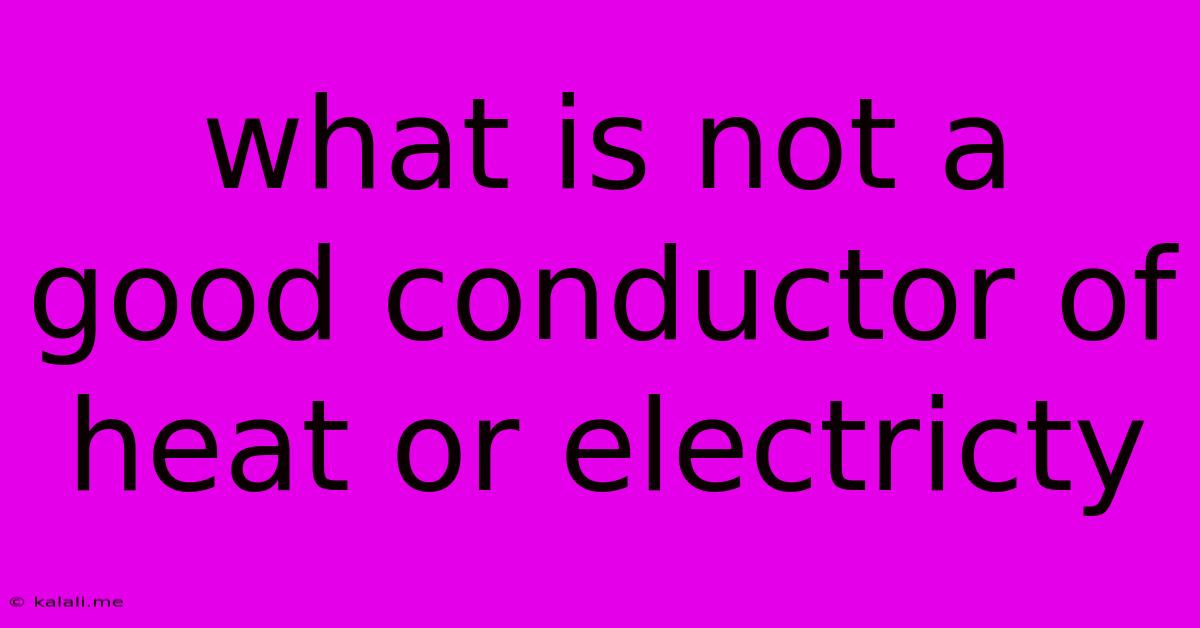What Is Not A Good Conductor Of Heat Or Electricty
Kalali
Jun 03, 2025 · 3 min read

Table of Contents
What is Not a Good Conductor of Heat or Electricity? Understanding Insulators
Heat and electricity are forms of energy that flow readily through certain materials, known as conductors. However, other materials significantly resist this flow, and these are called insulators. Understanding the properties of insulators is crucial in various applications, from keeping our homes warm to protecting electrical systems. This article will delve into the world of insulators, exploring what makes them poor conductors of heat and electricity, and providing examples of common insulating materials.
What Makes a Material a Poor Conductor?
The ability of a material to conduct heat or electricity depends largely on its atomic structure and the behavior of its electrons. Conductors have loosely bound electrons that can move freely, carrying the electrical charge or thermal energy. In contrast, insulators have tightly bound electrons that are not easily dislodged. This restricted electron movement hinders the flow of both heat and electricity.
Poor Conductors of Heat:
Heat transfer occurs through three primary mechanisms: conduction, convection, and radiation. Insulators effectively impede conduction, the transfer of heat through direct contact. Materials with low thermal conductivity are excellent heat insulators. Key characteristics that contribute to poor heat conductivity include:
- Low electron mobility: As mentioned, tightly bound electrons prevent efficient energy transfer.
- High density of tightly bound electrons: A dense electron cloud hinders the movement of thermal energy.
- High atomic mass: Heavier atoms vibrate less readily, slowing down heat transfer.
- Presence of air pockets or voids: Air itself is a poor conductor of heat, and materials with trapped air pockets, like foam, offer excellent insulation.
Examples of Poor Heat Conductors:
- Wood: Widely used in construction for its excellent insulating properties.
- Fiberglass: Common in home insulation, offering high thermal resistance.
- Plastic: Various plastics are used in appliances and building materials to prevent heat transfer.
- Rubber: Used in handles and protective coatings due to its low thermal conductivity.
- Air: As mentioned, air is a very poor conductor of heat; hence, double or triple-pane windows improve insulation by trapping air between the panes.
- Cork: A natural insulator, often used in wine bottle stoppers and underfloor insulation.
Poor Conductors of Electricity:
Similarly, electrical insulators impede the flow of electric current. Their tightly bound electrons resist the movement of charge carriers. Key factors contributing to poor electrical conductivity include:
- Large band gap: The energy required to excite electrons to a conduction state is high.
- High resistivity: Insulators have a very high resistance to the flow of electrical current.
- Lack of free electrons: The absence of mobile electrons limits current flow.
Examples of Poor Electrical Conductors:
- Rubber: Commonly used to insulate electrical wires and cables.
- Glass: Used in electrical components and as insulators in high-voltage applications.
- Ceramics: Many ceramic materials possess high electrical resistance.
- Plastics: Widely employed in electrical insulation due to their high resistivity.
- Air: A very effective electrical insulator, preventing current flow in many situations.
- Wood: Acts as an insulator, although its effectiveness can vary depending on moisture content.
The Importance of Insulators:
Insulators play a vital role in numerous applications. In construction, they help maintain comfortable indoor temperatures, reducing energy consumption. In electrical systems, they ensure safety by preventing short circuits and electric shocks. Understanding their properties is therefore crucial in designing safe and efficient technologies. From the humble rubber glove to the sophisticated insulation in power lines, these materials are essential components of our modern world. Further research into new and improved insulating materials remains a crucial area of development for energy efficiency and safety.
Latest Posts
Latest Posts
-
How To Train Your Dragon Toothless Drawing
Jun 05, 2025
-
How To Set Alarms In Hostels Without Waking Others Up
Jun 05, 2025
-
How Do You Get Food Coloring Off Skin
Jun 05, 2025
-
How To Delete Alias From Folder On Mac
Jun 05, 2025
-
How To Get Oil Off Cement
Jun 05, 2025
Related Post
Thank you for visiting our website which covers about What Is Not A Good Conductor Of Heat Or Electricty . We hope the information provided has been useful to you. Feel free to contact us if you have any questions or need further assistance. See you next time and don't miss to bookmark.